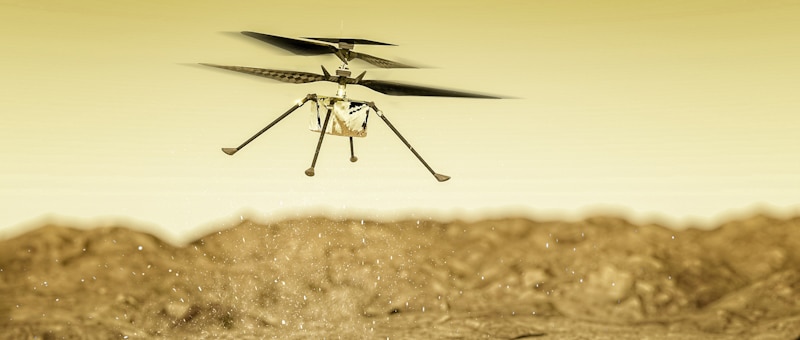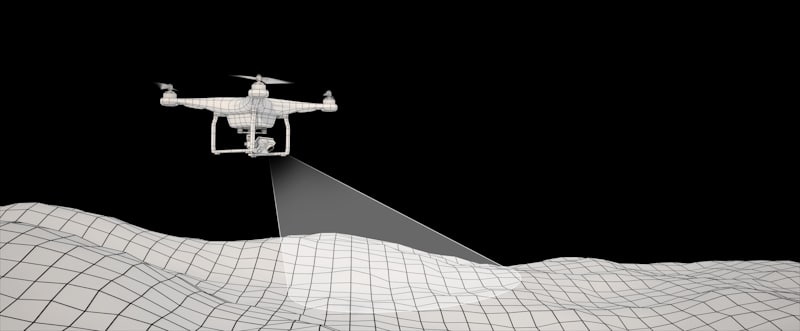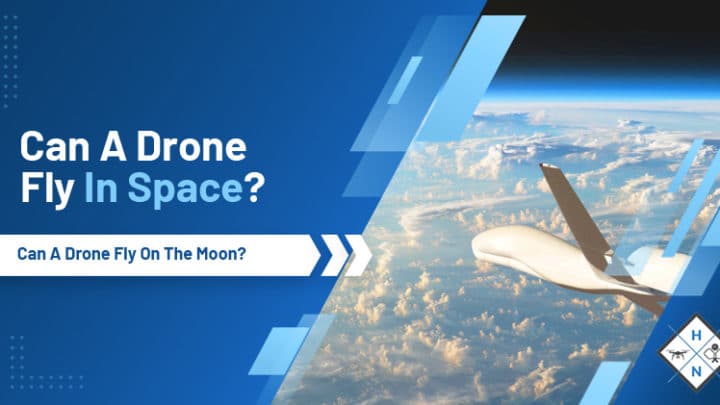Drones have become increasingly popular, especially for exploring and observing areas that are otherwise hard to reach. They are versatile and less risky compared to manned aircraft. With that said, is it possible to fly a drone in space? Can you fly one on the moon?
Simply put, yes, it is possible for drones to fly on the moon. However, their capability can be limited due to gravity conditions in the moon. It also depends on the composition of the environment of the moon and the specific features of the drone itself.

Why Are Drones Needed in Space?
Drones have been used for various reasons, including rescue missions, wildlife monitoring, aesthetics, inspections, explorations, military, and recreational purposes.
They are primarily used to observe places that are dangerous or aren't easily accessible to people. For example, they are used when astronauts need to collect samples in an environment considered "contaminated."
It is ideal to use robots and equipment such as drones to perform such tasks in such cases. Drones can also be used to observe and survey areas. This is the reason drones are being considered to fly to the moon. After all, sending people to the moon is costlier and riskier.
The Growing Interest in Using Drones
Drone technology has gone a long way. Nowadays, it's more than just for recreational use. In fact, there has been a growing interest in the use of drones for space explorations. Below are some examples of it.
The Arne Mission
The mission is named after Arne Saknussemm, a fictional character in the "Journey to the Center of the Earth" novel. This mission consists of three so-called "pit-bots": flying robots about 30 cm diameters and a landing spacecraft.
These pit-bots would then be used to discover what's inside the lava pits on the moon, allowing them to know if they are a cave system's surface expressions created by flowing lava.
Mars Helicopter
Ever wondered whether life has indeed existed before on Mars? Well, that is precisely the main reason NASA's JPL or Jet Propulsion Laboratory started working on the "Mars Helicopter." There have been various information about the composition of Mars.
Rovers have been sent out, but its onboard cameras only offered a limited view of the red planet. Hence, a flying scout has been considered to provide next-level information for further exploration.
The Mars Helicopter is a drone that looks like a helicopter. They wanted to create something that could guide astronauts to prevent potential hazards while they are out on their mission.
This drone is also intended to help plan the route of the primary rover. Of course, the process hasn't been that easy for the team.
The maximum flight altitude of the Mars helicopter is 130 ft. Additionally, it features a high-resolution camera facing downwards.
The team also considered the surface of Mars where the drone would land, so they aim to design it with shock-absorbing feet. These will allow it to land safely both on sandy terrain and hard gravel.
Beneath the motor shaft is an insulated box that keeps the sensors. The drone is expected to operate for three days every Martian day.
With the goal of autonomous control, this project required additional funding. For fear of it going over the mass budget, it has been considered excluded from the 2020 Mars mission.
Smart Gloves for Drone Control
Smart gloves have been tested at the Haughton-Mars Project. According to Intention, its developer, these "gloves" could make it possible for the astronauts to control robots using simple hand gestures.
Sensors and microcontrollers are embedded into the gloves, and these are the ones that allow the drones to read hand motions.
This means that astronauts can simply wave their hands so that the drones would get to their destination. This is more convenient than pressing buttons in controlling machinery.
With the use of the Epson Moverio AR-glasses, astronauts can receive real-time video feedback from the drone. The developers also consider incorporating other sensor types such as RF signals and Bluetooth to perform complex tasks soon.
They also have the intention of using artificial intelligence for a better controlling experience for the user. They are dreaming of a future where the machines understand humans instead of humans understanding how these machines work.
One of the problems faced by NASA here is how to allow astronauts to make those hand movements, considering that they are in a pressurized movement. So, they are trying to develop a new spacesuit that will enable precise hand movements.
They came up with an idea to allow astronauts to control the pressure inside so that whenever a specific task needs to be performed, they can lower the pressure anytime.
So far, the gloves have already been tested to control drones here on Earth, and just as expected, they work. However, no matter how great this idea is, certain adjustments need to be made regarding its design.
This is because the atmosphere and gravity in space are different from those on Earth. It still needs a lot of time and testing to prove that it's ready to be sent to the moon for exploration.
NASA’s Dragonfly Mission
The dragonfly mission is a "drone-like" device that NASA is planning to launch in 2026 to Titan, one of Saturn's moons. Its expected arrival on Titan is in 2034. The primary purpose is to collect organic samples from different environments.
So, what makes Titan the ideal place for the Dragonfly Mission? First of all, it has an interior water ocean. Second, compared to Earth, the temperature there is colder.
Nevertheless, both share similarities in terms of their chemical composition. Just like the Earth's atmosphere, it is mainly composed of nitrogen.
For NASA to carry out its mission to investigate the moon's surface, they have equipped the Dragonfly with a mass spectrometer, drill system, and neutron spectrometer. With these, scientists can further study the chemical composition of Titan.
With Titan's dense atmosphere and low gravity, the rotorcraft lander will rover around different locations and bring other sample materials while using little energy.
It is expected to fly more than 160km during its almost three-year mission, which is almost twice the distance that all rovers on Mars combined could travel.
It is specifically designed to operate in temperatures averaging -172.2 °C and recharged at night by a MMRTG. On a single charge, it is estimated to travel 10km. Having eight rotor propellers, it maneuvers like a drone.

Pentagon’s X-37B Space Drone
The US Air Force has been using its secret space drone to maneuver the different parts of the world, and it has been sent out again for its 6th mission. This drone is like a smaller version of crewed shuttles. It is about 9 meters long and weighs 5 tons.
Its mission this time is to deploy a FalconSat-8 research satellite. It also carried a service module. It has been sent out to help researchers with their experiments, including how radiation affects seeds. Its last mission ended in 2019 after spending a total of 2,865 days in space.
The Problem with Using Drones
Drones offer more possibilities for exploration. However, it is a known fact that they are typically operated within the Earth's atmosphere. This "atmosphere" allows the equipment to hover around. So, without it, it would not be easy to support its mass while it's on the moon.
Like airplanes, the thinner the air in the atmosphere is, the less efficient a drone flies. Lithium-ion batteries, typically used for operating drones, cannot run on low temperatures well.
More than that, drones don't work in space the same way as they do on Earth and the main reason for this is because they cannot push air. Considering that the moon has low air density and gravity, it would be pretty tricky to keep the drone stable.
While it might seem easy for rotors to keep drones in the air, it's not since the rotors are used in creating a thrust of air that is directed downwards, resisting gravity. For example, Mars is about 60 times denser than Earth.
Hence, more thrust is needed for it to fly in the air. The atmospheric density is a crucial consideration for determining the drone's mass since the heavier the drone is, the more difficult it is to fly.
One way to solve the problem mentioned before is by increasing the rotor's radius or increasing its rotation speed.
On the other hand, it is also not ideal for drones to be too light either since it is difficult to control. Compared to drones operated on Earth, the drones sent on space need to be autonomous, mainly since it's not currently possible to have real-time control over them. After all, it takes several hours just to send bits of data on Earth from space.
The next problem that scientists and developers face is solar polar availability since Mars is further from the Sun compared to the Earth, and electricity is needed for drones to operate.
Because of this, the battery capacity of the drone is another thing to consider. Nevertheless, this doesn't mean that flying it in space is an impossible thing to do. After all, there is no problem without a solution.

The Dream that NASA Has Been Trying to Achieve
Typical quadcopters require the use of a propulsion system since there is little to no air in space. Hence, the solution that NASA came up with is using a jet system in directing the drones to get to their desired position instead of using a propeller.
In the future, they also want drones to be able to fly autonomously. In other words, there would no longer be a need for someone to navigate it.
So far, they have tried out different rovers. However, they have encountered various obstacles along the way, such as steep mountains and voids. Hence, they view drones as something that could help them overcome it.
With NASA and other developers working hand in hand to make it possible for drones to reach space and with the continuous advancement in technology, more research opportunities would be open to the world.
Shawn Manaher loves to play with new toys and dive into new hobbies. As a serial entrepreneur, work definitely comes first but there is always room for hobbies.

